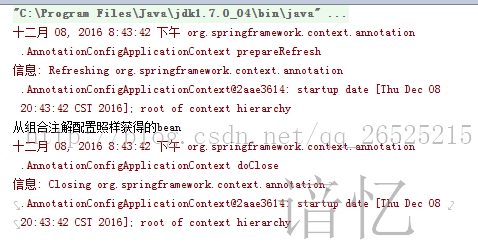
【Spring】Spring高级话题-组合注解与元注解
发布日期:2021-06-29 13:38:50
浏览次数:2
分类:技术文章
本文共 2907 字,大约阅读时间需要 9 分钟。
转载请注明出处:
本文源自【】
进行本示例的演示,需要先配置好Maven和Spring哦、
见:分析
所谓的元注解:
其实就是可以注解到别的注解上的注解。 而被注解的注解我们就称之为组合注解。(仔细理解,可能有点绕)组合注解同时具备元注解的功能!
Spring的很多注解都可以作为元注解,而且Spring本身已经有很多组合注解。
组合注解的好处:
简化了注解配置。也提供了很好的扩展性。比如@Configuration就是一个组合@Component注解,表明这个类其实也是一个Bean。
@Configuration的源码://// Source code recreated from a .class file by IntelliJ IDEA// (powered by Fernflower decompiler)//package org.springframework.context.annotation;import java.lang.annotation.Documented;import java.lang.annotation.ElementType;import java.lang.annotation.Retention;import java.lang.annotation.RetentionPolicy;import java.lang.annotation.Target;import org.springframework.stereotype.Component;@Target({ElementType.TYPE})@Retention(RetentionPolicy.RUNTIME)@Documented@Componentpublic @interface Configuration { String value() default "";} 有的时候,我们可能大量同时使用到几个注解到同一个类上,这个时候,我们就可以考虑将这几个注解到别的注解上。
比如下面的示例就是将@Configuration和@ComponentScan注解到一个注解上!
这样,我们就可以用一个注解来表示这两个注解。
示例
组合注解
package cn.hncu.p3.p5_annotation;import org.springframework.context.annotation.ComponentScan;import org.springframework.context.annotation.Configuration;import java.lang.annotation.*;/** * Created with IntelliJ IDEA. * User: 陈浩翔. * Date: 2016/12/8. * Time: 下午 4:00. * Explain:组合注解 */@Target(ElementType.TYPE)@Retention(RetentionPolicy.RUNTIME)@Documented@Configuration//组合@Configuration元注解 bean注解@ComponentScan//组合@ComponentScan元注解 自动扫描对应value(package路径)值下面的所有beanpublic @interface WiselyConfiguration { String[] value() default {};//覆盖value参数 //就是覆盖@ComponentScan注解中的value参数----必须要写,否则组合注解中放入value值时会报错} 解释一下@Documented:
表明这个注解应该被 javadoc工具记录. 默认情况下,javadoc是不包括注解的. 但如果声明注解时指定了 @Documented,则它会被 javadoc 之类的工具处理, 所以注解类型信息也会被包括在生成的文档中.服务Bean
package cn.hncu.p3.p5_annotation;import org.springframework.stereotype.Service;/** * Created with IntelliJ IDEA. * User: 陈浩翔. * Date: 2016/12/8. * Time: 下午 8:17. * Explain:服务Bean */@Servicepublic class DemoService { public void outputResult(){ System.out.println("从组合注解配置照样获得的bean"); }} 配置类
现在就只需要我们自定义的那个注解就可以代表那两个注解了。
package cn.hncu.p3.p5_annotation;/** * Created with IntelliJ IDEA. * User: 陈浩翔. * Date: 2016/12/8. * Time: 下午 8:19. * Explain:配置类--组合注解 */@WiselyConfiguration("cn.hncu.p3.p5_annotation")//自定义注解,扫描的所有的bean来源于value值所对应的包路径下//使用@WiselyConfiguration组合注解替代@Configuration和@ComponentScanpublic class DemoConfig { } 运行类
package cn.hncu.p3.p5_annotation;import org.springframework.context.annotation.AnnotationConfigApplicationContext;/** * Created with IntelliJ IDEA. * User: 陈浩翔. * Date: 2016/12/8. * Time: 下午 8:21. * Explain:运行类 */public class Main { public static void main(String[] args) { AnnotationConfigApplicationContext context = new AnnotationConfigApplicationContext(DemoConfig.class); DemoService demoService = context.getBean(DemoService.class); demoService.outputResult(); context.close(); }} 运行结果
本文章由编写, 所有权利保留。
转载请注明出处:
本文源自【】
转载地址:https://chenhx.blog.csdn.net/article/details/53523970 如侵犯您的版权,请留言回复原文章的地址,我们会给您删除此文章,给您带来不便请您谅解!
发表评论
最新留言
不错!
[***.144.177.141]2024年04月27日 15时50分35秒
关于作者

喝酒易醉,品茶养心,人生如梦,品茶悟道,何以解忧?唯有杜康!
-- 愿君每日到此一游!
推荐文章
如何构建私有的智能视觉系统
2019-04-29
OpenNCC智能视觉系统-基于Paddle的OCR模型迁移训练(一)
2019-04-29
dvsdk_3_10_00-19 编译
2019-04-29
DMAI GStreamer Plug-In 编译
2019-04-29
DM365 linux kernel 移植总结
2019-04-29
DM365 应用层gpio控制
2019-04-29
Vc6 Button 的WM_LBUTTONDOWN、WM_LBUTTONUP消息响应
2019-04-29
linux i2c子系统abc
2019-04-29
kernel 2.6.32 Unknown symbol 错误
2019-04-29
gstreamer GST_BOILERPLATE_FULL 分析
2019-04-29
力扣的两数之和解法(python3)
2019-04-29
力扣的删除排序数组中的重复项解法(python)
2019-04-29
力扣的移除元素 解法 Python3
2019-04-29
力扣的三数之和解法(Python3)
2019-04-29
力扣的最接近的三数之和解法(Python3)
2019-04-29
力扣的买卖股票的最佳时机 III之解法(Python3)
2019-04-29
LeetCode 合并两个有序链表 解法 (Python)
2019-04-29
力扣的删除排序链表中的重复元素解法 (Python3)
2019-04-29
力扣的环形链表解法 (Python)
2019-04-29
力扣的盛最多水的容器解法 (Python)
2019-04-29
